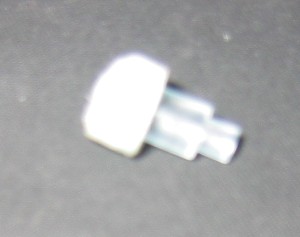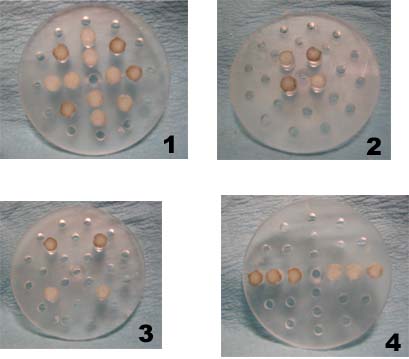new web: http://bdml.stanford.edu/pmwiki
TWiki > Haptics Web>StanfordHaptics>PolyurethaneDesigns (30 Aug 2005, KarlinBark)
Haptics Web>StanfordHaptics>PolyurethaneDesigns (30 Aug 2005, KarlinBark)
-- KarlinBark - 06 Jul 2005
Earlier, we were applying skin stretch using two contact points, but we wanted to test different methods of applying skin stretch. Below are some of the configurations I've used to apply a rotational skin stretch using the new test pieces made using SDM processes. The plastic is IE-72DC polyurethane and the white, softer material is IE-20A polyurethane.
 Because the 4 point contact worked pretty well, I tried using a ring of contact points as well, and this worked well, grasping a lot of skin and didn't seem to slip as much as the 4 point configuration, probably because there was less room for the contact points to slip. One of the drawbacks of the test pieces were that at higher displacements/torques, my skin would be "wrapped" around the pins, and the thin layer of 20A polyurethane wasn't enough to protect my skin from the sharper edges of the harder plastic. You can see the pin in the photo below, although it's slightly blurry. It would probably be better to wrap the entire pin with a layer of polyurethane.
Because the 4 point contact worked pretty well, I tried using a ring of contact points as well, and this worked well, grasping a lot of skin and didn't seem to slip as much as the 4 point configuration, probably because there was less room for the contact points to slip. One of the drawbacks of the test pieces were that at higher displacements/torques, my skin would be "wrapped" around the pins, and the thin layer of 20A polyurethane wasn't enough to protect my skin from the sharper edges of the harder plastic. You can see the pin in the photo below, although it's slightly blurry. It would probably be better to wrap the entire pin with a layer of polyurethane.
 I also tried using a solid ring to stretch the skin, you can see the solid ring attached to the device in the pic below. I also used a thicker layer of polyurethane. This seemed to help with the stickiness of the 20A, but It may also be due to variations in curing.
I also tried using a solid ring to stretch the skin, you can see the solid ring attached to the device in the pic below. I also used a thicker layer of polyurethane. This seemed to help with the stickiness of the 20A, but It may also be due to variations in curing.
 The ring was actually very good in stretching skin, and the thicker, stickier layer of 20A felt better, and my skin was not in contact with any sharp edges.
JULY 25- 2005 UPDATE
I tried making some different sized rings, and improving the pin shape, so that it would not cause any pain when applying skin stretch.
The ring was actually very good in stretching skin, and the thicker, stickier layer of 20A felt better, and my skin was not in contact with any sharp edges.
JULY 25- 2005 UPDATE
I tried making some different sized rings, and improving the pin shape, so that it would not cause any pain when applying skin stretch.
 The smaller rings seemed to work just as well as the larger ones, there wasn't really much of a difference from before. But obviously it shows that the rings can be smaller( ~0.8 inches in diameter)
The smaller rings seemed to work just as well as the larger ones, there wasn't really much of a difference from before. But obviously it shows that the rings can be smaller( ~0.8 inches in diameter)
 I also tried changing the pins to the above shape, to try and alleviate some of the pain that occurred using the previous pin shape. However, this new pin shape with the polyurethane covering the entire bottom portion, wasn't very good. The polyurethane was too soft, and didn't seem to grip the skin as well. The 20A polyurethane also didn't seem to bond to the harder 72DC urethane well, so the softer/sticker portion of the pin moves around quite a bit and prevents the skin from being stretched properly.
overall, the ring shape seems to be the best.
I also tried changing the pins to the above shape, to try and alleviate some of the pain that occurred using the previous pin shape. However, this new pin shape with the polyurethane covering the entire bottom portion, wasn't very good. The polyurethane was too soft, and didn't seem to grip the skin as well. The 20A polyurethane also didn't seem to bond to the harder 72DC urethane well, so the softer/sticker portion of the pin moves around quite a bit and prevents the skin from being stretched properly.
overall, the ring shape seems to be the best.
- combos.jpg:

| configuration | pros | cons |
|---|---|---|
| 1 | *the increased contact area creates a larger sensation of skin stretch *when slipping occurs, there are so many contact points that some skin is always stretched |
*the contact area is too big, cannot form to the different contours of the arm well *requires a large normal force to maintain contact with all the points |
| 2 | *small contact patch allows it to be placed in a variety of spots | *doesn't create a good sensation of stretching skin, more like twisting in a single area |
| 3 | *works pretty well and stretches skin a lot *more stretching than two point contact |
*skin gets "wrapped around" pins and this can cause some pain |
| 4 | none | this just doesn't work well at all |
 Because the 4 point contact worked pretty well, I tried using a ring of contact points as well, and this worked well, grasping a lot of skin and didn't seem to slip as much as the 4 point configuration, probably because there was less room for the contact points to slip. One of the drawbacks of the test pieces were that at higher displacements/torques, my skin would be "wrapped" around the pins, and the thin layer of 20A polyurethane wasn't enough to protect my skin from the sharper edges of the harder plastic. You can see the pin in the photo below, although it's slightly blurry. It would probably be better to wrap the entire pin with a layer of polyurethane.
Because the 4 point contact worked pretty well, I tried using a ring of contact points as well, and this worked well, grasping a lot of skin and didn't seem to slip as much as the 4 point configuration, probably because there was less room for the contact points to slip. One of the drawbacks of the test pieces were that at higher displacements/torques, my skin would be "wrapped" around the pins, and the thin layer of 20A polyurethane wasn't enough to protect my skin from the sharper edges of the harder plastic. You can see the pin in the photo below, although it's slightly blurry. It would probably be better to wrap the entire pin with a layer of polyurethane.
 I also tried using a solid ring to stretch the skin, you can see the solid ring attached to the device in the pic below. I also used a thicker layer of polyurethane. This seemed to help with the stickiness of the 20A, but It may also be due to variations in curing.
I also tried using a solid ring to stretch the skin, you can see the solid ring attached to the device in the pic below. I also used a thicker layer of polyurethane. This seemed to help with the stickiness of the 20A, but It may also be due to variations in curing.
 The ring was actually very good in stretching skin, and the thicker, stickier layer of 20A felt better, and my skin was not in contact with any sharp edges.
JULY 25- 2005 UPDATE
I tried making some different sized rings, and improving the pin shape, so that it would not cause any pain when applying skin stretch.
The ring was actually very good in stretching skin, and the thicker, stickier layer of 20A felt better, and my skin was not in contact with any sharp edges.
JULY 25- 2005 UPDATE
I tried making some different sized rings, and improving the pin shape, so that it would not cause any pain when applying skin stretch.
Ideas, requests, problems regarding TWiki? Send feedback